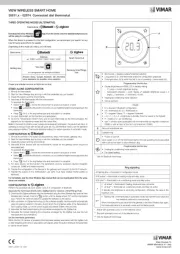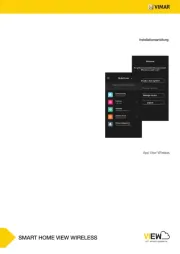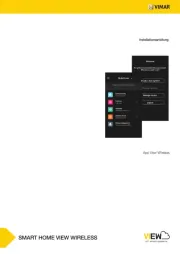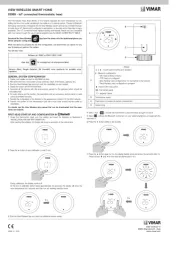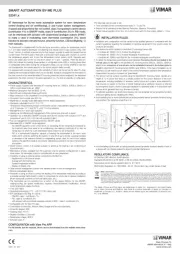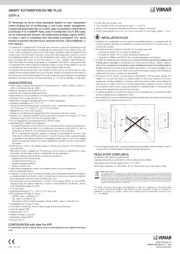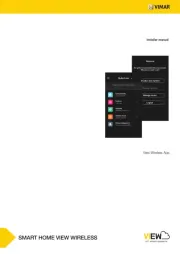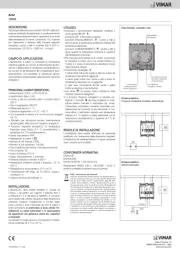Termostato elettronico a rotella per controllo della temperatura ambiente
(riscaldamento e condizionamento), domotica standard KNX, dispositivo di
controllo della temperatura di classe I (contributo 1%) in modalità ON/OFF,
di classe IV (contributo 2%) in modalità PI, interfacciabile con attuatore con
uscite analogiche proporzionali KNX per realizzare un termostato d’ambiente
modulante di classe V (contributo 3%), 1 ingresso per sensore elettronico di
temperatura 20432, 19432 o 14432 o sensore di temperatura filare 02965.1,
1 ingresso digitale programmabile, retroilluminazione a led bianca, grigio - 2
moduli. Da completare con placche Linea, Eikon, Arké, Plana. Per Idea instal-
labile con supporto dedicato 16723.
Il termostato è provvisto di rotella frontale per l’impostazione del setpoint (da 4°C a 40°C) e di
un display centrale retroilluminato a led bianchi che visualizza la temperatura misurata mostran-
do il setpoint solo quando si agisce sulla rotella. La ghiera intorno al display, retroilluminata in
RGB, visualizza tutti gli stati del termostato. Il dispositivo è provvisto di 4 tasti frontali utilizzabili
per le impostazioni. La configurazione del termostato, dell’indirizzo fisico, dei parametri e del
suo funzionamento avviene mediante il software ETS.
CARATTERISTICHE.
• Tensione di alimentazione BUS: 29 V
• Assorbimento dal BUS: 17,5 mA
• Morsetti:
- 2 per bus KNX
- 2 per sonda si temperatura esterna (art. 02965.1 e 20432-19432-14432)
Lunghezza massima del cavo di collegamento del sensore esterno: 60 m.
- 2 per ingresso digitale privo di potenziale (SELV)
Lunghezza massima del cavo di collegamento su ingresso contatto pultito: 30 m.
Per gli ingressi utilizzare un cavo twistato con sezione minima di 0.5 mm
2 (art. 01840).
• 4 tasti frontali per comando e configurazione/reset.
• LED RGB per segnalazione stato di configurazione (lampeggiante blu) e lo stato dell’uscita
(colore configurabile).
• Precisione misura temperatura:
- sensore integrato: range di misura da 0 a 40°, ±0.5 °C tra 15 °C e 30 °C, ±0.8 °C agli
estremi;
- sensore esterno ausiliare: come sensore integrato. Oltre alla temperatura di funzionamento
del dispositivo l’errore del sensore esterno ausiliario aumenta fino ad un max di 2.5°C @
80°C.
• Differenziale termico: regolabile tra 0.1°C e 1°C
• Gestione Impianti con 2 e 4 tubi.
• Riscaldamento, condizionamento con gestione della zona neutra (solo con 4 tubi).
• Pilotaggio tramite apposito attuatore di valvole caldo/freddo di tipo On/Off o di tipo propor-
zionale (0-10 V, 4-20 mA).
• Gestione fancoil (3 velocità/proporzionali, valvole on/off).
• Algoritmo di regolazione ON/OFF o PID selezionabile:
- l’algoritmo ON/OFF è il controllo nel quale, al superamento della temperatura impostata
aumentata di un valore di soglia (viceversa per il condizionamento), il riscaldamento viene
spento per poi riaccendersi quando la temperatura ambiente scende al di sotto della
temperatura impostata.
- il PID è un algoritmo evoluto in grado di mantenere più stabile la temperatura dell’ambiente
e agisce accendendo e spegnendo opportunamente l’impianto in modo da risultare come
un graduale aumento o calo della potenza termica (o refrigerante) dell’impianto stesso;
ideale negli impianti a pavimento, l’algoritmo necessita di essere opportunamente calibrato
in base al tipo di ambiente e di impianto.
• Funzione boost: comando di un attuatore ausiliario per velocizzare il riscaldamento o il con-
dizionamento dell’ambiente.
• Funzione Mezza stagione: disponibile da supervisore solo per impianti configurati a 4 tubi,
quando è attiva viene comandata l’uscita secondaria con i propri parametri.
• Ingresso per sensore esterno (art. 02965.1-20432-19432-14432) le cui funzioni sono le
seguenti:
- Sostituzione del sensore interno.
- Media con quello interno.
- Limitazione temperatura massetto.
- Sola visualizzazione su display.
• Funzione di gestione finestra aperta con gestione del ritardo in accensione e spegnimento.
• Dispositivo gestibile da remoto.
• Dispositivo interfacciabile in modo nativo con sistemi di terze parti (sistemi KNX).
• Possibilità di utilizzare un offset per correggere la lettura della temperatura misurata in accor-
do con eventuale termometro campione in modo da compensare errori dovuti ad installazioni
particolari (muro a nord, vicinanza a tubi acqua calda/fredda, ecc.).
• Temperatura di funzionamento: 0 °C +40 °C (uso interno).
• Classificazione ErP (Reg. UE 811/2013): - ON/OFF: classe I, contributo 1%. - PID: classe IV,
contributo 2%.
• Configurabile tramite il software ETS.
FUNZIONAMENTO.
Attraverso i tasti frontali, il display, la rotella e la ghiera che la delimita è possibile personalizzare
e visualizzare le modalità di funzionamento ON/OFF del termostato, lo stato dell’impianto (in
funzione o no) nonché la modalità stagionale (raffrescamento, riscaldamento).
RAEE - Informazione agli utilizzatori
Il simbolo del cassonetto barrato riportato sull’apparecchiatura o sulla sua confezione indica che il prodotto alla fine della propria vita utile
deve essere raccolto separatamente dagli altri rifiuti. L’utente dovrà, pertanto, conferire l’apparecchiatura giunta a fine vita agli idonei centri
comunali di raccolta differenziata dei rifiuti elettrotecnici ed elettronici. In alternativa alla gestione autonoma, è possibile consegnare gra-
tuitamente l’apparecchiatura che si desidera smaltire al distributore, al momento dell’acquisto di una nuova apparecchiatura di tipo equi-
valente. Presso i distributori di prodotti elettronici con superficie di vendita di almeno 400 m
2 è inoltre possibile consegnare gratuitamente,
senza obbligo di acquisto, i prodotti elettronici da smaltire con dimensioni inferiori a 25 cm. L’adeguata raccolta differenziata per l’avvio
successivo dell’apparecchiatura dismessa al riciclaggio, al trattamento e allo smaltimento ambientalmente compatibile contribuisce ad evi-
tare possibili effetti negativi sull’ambiente e sulla salute e favorisce il reimpiego e/o riciclo dei materiali di cui è composta l’apparecchiatura.
CONFIGURAZIONE.
Per tutti i dettagli relativi agli oggetti di comunicazione ETS, ai parametri e alla configu-
razione del dispositivo, si consulti il manuale Welll-contact Plus scaricabile dalla sezione
“Download -> Software -> Well-contact Plus” del sito www.vimar.com.
L’utente, mediante i tasti frontali, potrà modificare il set point di temperatura e la velocità del fan-
coil; la modifica di questi parametri forza il termostato in funzionamento manuale.
REGOLE DI INSTALLAZIONE.
• L’installazione e la configurazione deve essere effettuata da personale qualificato con l’os-
servanza delle disposizioni regolanti l’installazione del materiale elettrico in vigore nel paese
dove i prodotti sono installati.
• L’apparecchio deve essere installato in scatole da incasso o da parete con i relativi supporti e
placche, a un’altezza di 1,5 m dal piano di calpestio, in una posizione idonea alla corretta rile-
vazione della temperatura ambiente, evitando l’installazione in nicchie, dietro porte e tende,
zone influenzate da fonti di calore o soggette al flusso di sorgenti a ventilazione forzata di
riscaldamento/raffrescamento o influenzate da fattori atmosferici. In particolare si deve evitare
l’installazione su pareti perimetrali o in associazione ad apparecchi che generano calore (es.
regolatori o lampade).
CONFORMITÀ NORMATIVA.
Direttiva EMC. Direttiva RoHS. Norme EN IEC 60669-2-1, EN50491-2, EN IEC 63044, EN
IEC 63000.
Regolamento dispositivi di controllo della temperatura (UE) n° 811/2013.
Regolamento REACh (UE) n. 1907/2006 – art.33. Il prodotto potrebbe contenere tracce di
piombo.
Electronic dial thermostat for room temperature control (heating and air
conditioning), KNX standard home automation system, class I temperature
control device (contribution 1%) in ON/OFF mode, class IV (contribution 2%)
in PID mode, can be interfaced with actuator with KNX proportional analogue
outputs to implement a class V modulating room thermostat (contribution
3%), 1 input for electronic temperature sensor 20432, 19432 or 14432 or
wired temperature sensor 02965.1, 1 programmable digital input, white/grey
LED backlighting - 2 modules. To be completed with Linea, Eikon, Arké,
Plana cover plates. For Idea, can be installed using the dedicated mounting
frame 16723.
The thermostat is fitted with a front dial to adjust the setpoint (between 4°C and 40°C) and a
central white LED backlit display to show the measured temperature, and show the setpoint
only when the dial is being used. The circular ring around the display, with RGB backlighting,
displays all the thermostat statuses. The device is fitted with 4 front buttons to be used for
setting. The thermostat, physical address, parameters and its operation, etc. are configured
via the ETS software.
CHARACTERISTICS.
• BUS supply voltage: 29 V
• Absorption from the BUS: 17.5 mA
• Terminals:
- 2 for KNX bus
- 2 for external temperature probe (art. 02965.1 and 20432-19432-14432)
Maximum length of the external sensor connection cable: 60 m.
- 2 for voltage-free digital input (SELV)
Maximum length of the connection cable on the voltage-free contact input: 30 m.
For the inputs, use a twisted cable with a minimum cross-section of 0.5 mm
2 (art. 01840).
• 4 front buttons for control and configuration/reset.
• RGB LED for configuration status (flashing blue) and output status (configurable colour)
signalling.
• Temperature measurement precision:
- built-in sensor: measurement range from 0 to 40°, ±0.5 °C between 15 °C and 30 °C, ±0.8
°C at the extremes;
- auxiliary external sensor: like the built-in sensor. Beyond the operating temperature of the
device, the error of the auxiliary external sensor increases up to max 2.5°C @ 80°C.
• Hysteresis: adjustable from 0.1°C to 1°C
• Management of 2- and 4-pipe systems.
• Heating, air conditioning with management of the neutral zone (only with 4 pipes).
• Operation via a dedicated ON/OFF or proportional hot/cold valve actuator (0-10 V, 4-20 mA).
• Fan coil management (3 speeds/proportional, ON/OFF valves).
• Selectable PID or ON/OFF control algorithm:
- the ON/OFF algorithm is the control which, on exceeding the set temperature increased by
the threshold value (vice versa for air conditioning), the heating is switched off to then be
turned back on when the room temperature drops below the set temperature.

